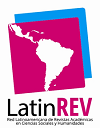Legal Aspects of the conflict over seed saving of genetically modified soybean in Argentina: 1996-2019
DOI:
https://doi.org/10.24215/18522971e070Keywords:
seed law, GM seeds, royalties, seed savingsAbstract
Over the last fifteen years, numerous bills regarding the regulation of seed saving were discussed. At the heart of these debates lies the conflict over fees collection, which is particularly relevant to genetically modified soybeans, which are (as well as their by-products) Argentina's main export commodity. In this regard, the possibility of appropriating royalties for seed saving is tied to the regulation of intellectual property rights. Hence, a significant part of the conflict is linked to the efforts to modify the current legislation. In this paper we aim to analyze these issues. Thus, after synthesizing some relevant aspects of the conflict, we will dwell on the analysis of the legal framework that regulates intellectual property rights over plant organisms. We will then analyze of the role played by the legislation in this conflict and the actions of different social actors around this legal framework, linking these issues with the dynamics presented by the accumulation of capital in the seed production branch.
Downloads
References
Blair, D. (1999). Intellectual property protection and its impact on the U.S. seed industry. Drake journal of agriculturallaw, 4, 297-391.
Casella, A. (2005). Federación Agraria profundiza en contenidos. En FAA, Patentamiento y regalías en semillas: un país que resigna soberanía. Accionar y posición de Federación Agraria Argentina (págs. 55-175). Rosario: FAA.
Correa, C. (diciembre de 2010). A Monsanto perdesua patente. Le monde diplomatique. Recuperado el 02 de 11 de 2017, de http://diplomatique.org.br/a-monsanto-perde-sua-patente/
Dhar, T., & Foltz, J. (2007). The impact of intellectual property rights in the plant and seed industry. En J. Kesan, Agricultural biotechnology and intellectual property. Seeds of change (págs. 161-171). Oxfordshire/Cambridge: CABI.
FAA. (2005). Patentamiento y regalías en semillas: un país que resigna soberanía. Accionar y posición de Federación Agraria Argentina. Rosario: FAA.
Fernández Cornejo, J. (2004). The seed industry in U.S. agriculture. Agriculture Information Bulletin Number 786. Washington: United States Department of Agriculture.
Filomeno, F. (2014). Monsanto and intellectual property in South America.New York: PalgraveMacMillan.
Fridman, S. (2001). Biotecnología: derechos del obtentor y del agricultor; alternativas legislativas. Universidad Nacional del Nordeste. Recuperado el 03 de 11 de 2017, de www.unne.edu.ar/unnevieja/Web/cyt/cyt/2001/1-Sociales/S-018.pdf
Gianni, C. (2010). Distintas facetas de las variedades vegetales. Tomo I: la propiedad intelectual de las variedades vegetales. El derecho de obtentor. Buenos Aires: Edición del Instituto Nacional de Semillas.
Gutiérrez, M., &Penna, J. (2004). Derechos de obtentor y estrategias de marketing en la generación de variedades públicas y privadas. Documento de trabajo no. 31. INTA.
Helfer, L. (2005). Derechos de propiedad intelectual sobre variedades vegetales. Regímenes jurídicos internacionales y opciones para los gobiernos. Roma: FAO.
INPI (2015). Informe 141.277. Instituto Nacional de la Producción Industrial: Buenos Aires.
Iñigo Carrera, J. (2007). La formación económica de la sociedad argentina. Volumen I. Renta agraria, ganancia industrial y deuda externa. 1882–2004. Buenos Aires: Imago Mundi.
ISF. (2015). Generating value in the soybean chain production through royalty collection: an international study.ISF.
Janis, M., &Kesan, J. (2002a). Intellectual property protection for plant innovation: Unresolved issues after J.E.M. v. Pioneer. Nature biotechnology, 20, 1161-1164.
Janis, M., &Kesan, J. (2002b). U.S. Plant Variety Protection: sound and fury...? Houston law review, 39, 727-778.
Kloppenburg, J. (2004). First the seed. The political economy of plant biotechnology, 1492-2000 (second edition).Madison: Cambridge UniversityPress.
Marx, K. (2006 [1867]). El capital. Tomo I, 3 vols. Buenos Aires: Siglo XXI.
Perelmuter, T. (2017). Ley de semillas en Argentina: avatares de una reforma que (aún) no fue. Revista Interdisciplinaria de Estudios Agrarios, 47, 75-110.
Perelmuter, T. (2018). Propiedad intelectual en semillas: los dispositivos del cercamiento jurídico en Argentina. Mundo Agrario, 19(42), 1-18.
Pérez Trento, N. (2019). Dos décadas de conflicto en torno al uso propio de semillas de soja en Argentina: acumulación de capital, derechos de propiedad intelectual y actores sociales (1996-2018). Mundo Agrario, 43(20), 1-21. doi:10.24215/15155994e105
Qaim, M., &Traxler, G. (2005). Roundup Ready soybeans in Argentina: farm level and aggregate welfare effects. Agriculturaleconomics, 32, 73-86.
Sánchez Herrero, A. (2006). La excepción del agricultor: análisis dogmático. En M. Rapela, & G. Schötz, Innovación y propiedad intelectual en mejoramiento vegetal y biotecnología agrícola (págs. 159-206). Buenos Aires: Heliasta - Universidad Austral.
SRA (2004). Anales de la Sociedad Rural Argentina, número 3. Buenos Aires: SRA.
Stein, H. (2005). Intellectual property and genetically modified seeds: the United States, trade, and the developing world. Northwestern Journal of Technology and Intellectual Property, 3(2), 160-178.
Strubbia, M., & Sánchez Herrero, A. (2006). La cláusula de regalía extendida en el contrato de compraventa de semillas. En M. Rapela, & G. Schötz, Innovación y propiedad intelectual en mejoramiento vegetal y biotecnología agrícola (págs. 433-474). Buenos Aires: Heliasta - Universidad Austral.
Trigo, E., Chudnovsky, E., Cap, D., & López, A. (2002). Los transgénicos en la agriultura argentina.Buenos Aires: Librosdelzorzal.
United States General Accounting Office. (2000). Biotechnology: Information on prices of genetically modified seeds in the United States and Argentina.Recuperado el 21 de 02 de 2018, de https://www.gao.gov/assets/230/228726.pdf
Witthaus, M. (2006). Superposición y contradicciones en la legislación argentina sobre derechos del obtentor y derechos de patentes. En M. Rapela, Innovación y propiedad intelectual en mejoramiento vegetal y biotecnología agrícola (págs. 243-268). Buenos Aires: Heliasta-Universidad Austral.
Witthaus, M., &Rapela, M. (2006). Vacíos de protección en la legislación argentina sobre derechos del obtentor y patentes. En M. Rapela, & G. Schötz, Innovación y propiedad intelectual en mejoramiento vegetal y biotecnología agrícola (págs. 269-292). Buenos Aires: Heliasta - Universidad Austral.
Downloads
Published
How to Cite
Issue
Section
License
Los autores/as conservan los derechos de autor y ceden a la revista el derecho de la primera publicación, con el trabajo registrado con la licencia de atribución, compartir igual, de Creative Commons, que permite a terceros utilizar lo publicado siempre que mencionen la autoría del trabajo y a la primera publicación en esta revista.

Derecho y Ciencias Sociales por Facultad de Ciencias Jurídicas y Sociales se distribuye bajo una Licencia Creative Commons Atribución-CompartirIgual 4.0 Internacional.

























